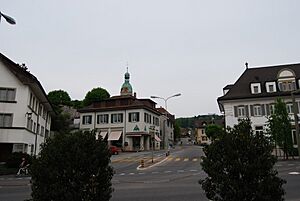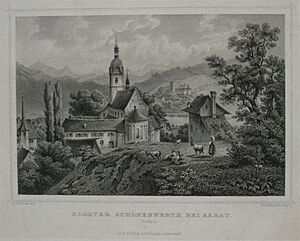Schönenwerd facts for kids
Quick facts for kids
Schönenwerd
|
||
|---|---|---|
|
||
| Country | Switzerland | |
| Canton | Solothurn | |
| District | Olten | |
| Area | ||
| • Total | 3.71 km2 (1.43 sq mi) | |
| Elevation | 386 m (1,266 ft) | |
| Population
(Dec 2020 )
|
||
| • Total | 5,057 | |
| • Density | 1,363.1/km2 (3,530/sq mi) | |
| Postal code |
5012
|
|
| Surrounded by | Eppenberg-Wöschnau, Gretzenbach, Niedererlinsbach, Niedergösgen, Oberentfelden (AG), Unterentfelden (AG) | |
Schönenwerd is a cool town, or 'municipality,' located in the Olten area of Solothurn, a 'canton' (like a state) in Switzerland. It's a place with a long history and a mix of nature and buildings.
Contents
History of Schönenwerd
Schönenwerd was first mentioned way back in the year 778. Back then, it was called Werith. Imagine how much has changed since then!
Exploring Schönenwerd's Geography
Schönenwerd covers an area of about 3.73 square kilometers (1.44 square miles). A big part of this area, about 43.2%, is covered by forests, which is great for nature lovers! About 10.5% of the land is used for farming, and 41.6% has buildings and roads.
The town is located in the Olten district. It stretches from the old St. Leodegar church, which sits on a hill, all the way down to the Aare river.
Schönenwerd's Coat of Arms
The town's coat of arms has three horizontal stripes: red, white, and black. On top of these stripes, there's a special flower symbol called a Fleur de lis. This symbol changes color depending on the stripe it's on, making it look really unique!
People and Population in Schönenwerd
Schönenwerd has a population of 5,057 people. About 35.8% of the people living here are from other countries.
Languages Spoken in Schönenwerd
Most people in Schönenwerd speak German, which is about 77.8% of the population. The second most common language is Italian, spoken by about 9.2% of the people. Some people also speak Serbo-Croatian, French, and Romansh.
Where People in Schönenwerd Were Born
Many people in Schönenwerd were born right there in the town (about 23%). Others were born in the same canton (Solothurn), while some came from other parts of Switzerland or from outside Switzerland.
Historical Population Growth
The number of people living in Schönenwerd has changed a lot over time. You can see how the population has grown and changed in the chart below:

Important Heritage Sites
Schönenwerd has some very important historical places. The Bally Areal, the Christian Catholic collegiate church of St. Leodegar, and the Granary in Ballypark are all listed as important Swiss heritage sites. The whole village of Schönenwerd is even part of the Inventory of Swiss Heritage Sites!
Economy and Jobs in Schönenwerd
In Schönenwerd, many people have jobs in different areas.
- A small number of people work in the primary sector, which means jobs like farming.
- Many people work in the secondary sector, which includes jobs in manufacturing (making things) and construction (building things).
- The largest number of people work in the tertiary sector. This includes jobs in:
- Sales (like shops and car repair)
- Moving and storing goods
- Hotels and restaurants
- Information technology
- Insurance and finance
- Science and technical jobs
- Education (teachers!)
- Health care
Many people who live in Schönenwerd travel to other towns for work, and many people from other towns come to Schönenwerd to work. About 23.6% of workers use public transportation, and 51.4% drive their own cars.
Religions in Schönenwerd
People in Schönenwerd follow different religions.
- About 38.5% are Roman Catholic.
- About 28.6% belong to the Swiss Reformed Church.
- There are also people who are Orthodox Christians, Christian Catholics, and other Christian faiths.
- About 7.69% of the population is Islamic.
- Smaller numbers of people are Buddhist or Hindu.
- About 12.43% of the people do not belong to any church.
Transportation in Schönenwerd
Schönenwerd is located on the Olten–Aarau railway line. This means it has its own train station, Schönenwerd railway station, making it easy for people to travel by train.
Education in Schönenwerd
Education is important in Schönenwerd!
- Many adults (about 33.7%) have completed high school, and some (about 8.7%) have gone on to university or other higher education.
- In the 2010–2011 school year, there were 180 students in Schönenwerd's school system.
- In the Canton of Solothurn, children can go to kindergarten for two years before primary school.
- Students attend six years of primary school.
- After primary school, there are three years of required lower secondary school, followed by optional advanced schools. 180 students attended lower secondary school in Schönenwerd.
- Some students from Schönenwerd go to schools in other towns, and students from other towns come to study in Schönenwerd.
- The SIS Swiss International School Schönenwerd is also located in the town.
See also
 In Spanish: Schönenwerd para niños
In Spanish: Schönenwerd para niños







